英语专业四级英语倒装句浓缩版
- 格式:docx
- 大小:19.12 KB
- 文档页数:6
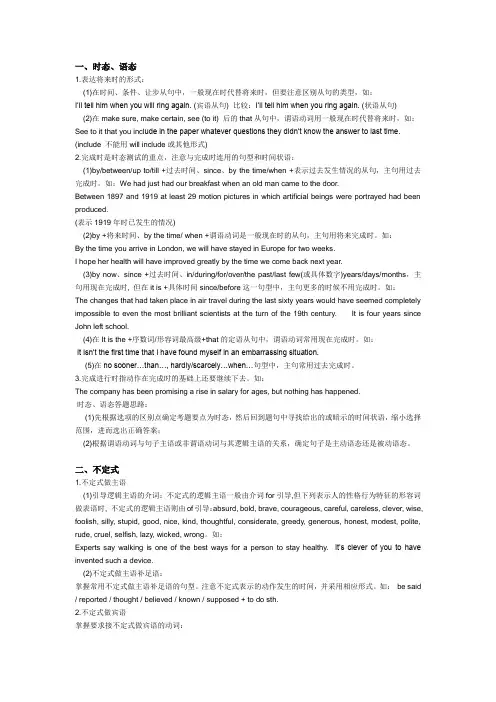
一、时态、语态1.表达将来时的形式:(1)在时间、条件、让步从句中,一般现在时代替将来时,但要注意区别从句的类型,如:I’ll tell him when you will ring again. (宾语从句) 比较:I’ll tell him when you ring again. (状语从句)(2)在make sure, make certain, see (to it) 后的that从句中,谓语动词用一般现在时代替将来时,如:See to it that you incl ude in the paper whatever questions they didn’t know the answer to last time. (include 不能用will include或其他形式)2.完成时是时态测试的重点,注意与完成时连用的句型和时间状语:(1)by/between/up to/till +过去时间、since、by the time/when +表示过去发生情况的从句,主句用过去完成时。
如:We had just had our breakfast when an old man came to the door.Between 1897 and 1919 at least 29 motion pictures in which artificial beings were portrayed had been produced.(表示1919年时已发生的情况)(2)by +将来时间、by the time/ when +谓语动词是一般现在时的从句,主句用将来完成时。
如:By the time you arrive in London, we will have stayed in Europe for two weeks.I hope her health will have improved greatly by the time we come back next year.(3)by now、since +过去时间、in/during/for/over/the past/last few(或具体数字)years/days/months,主句用现在完成时, 但在it is +具体时间since/before这一句型中,主句更多的时候不用完成时。
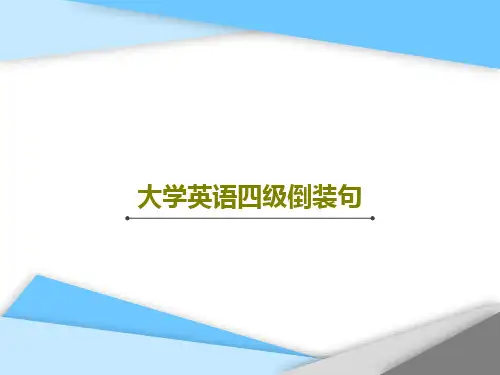
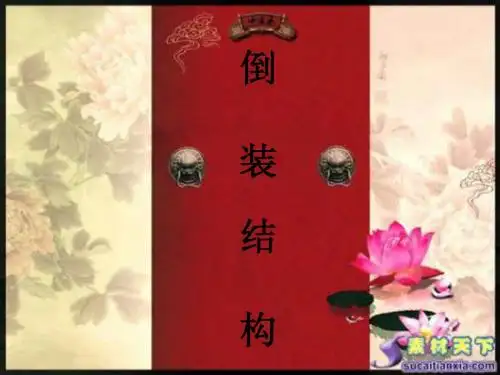
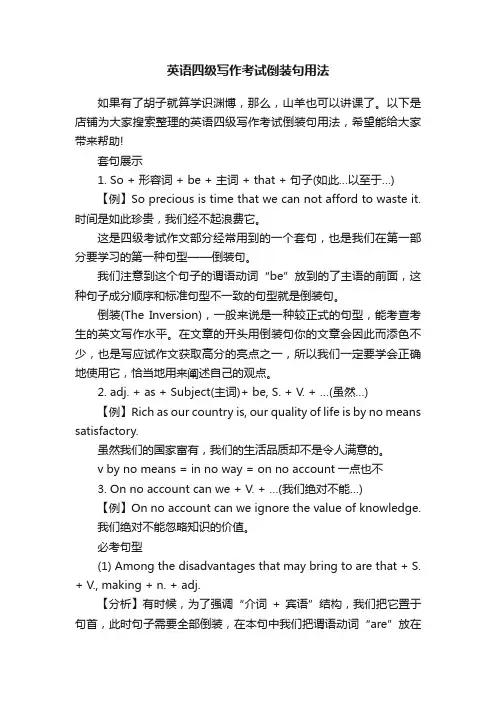
英语四级写作考试倒装句用法如果有了胡子就算学识渊博,那么,山羊也可以讲课了。
以下是店铺为大家搜索整理的英语四级写作考试倒装句用法,希望能给大家带来帮助!套句展示1. So + 形容词 + be + 主词 + that + 句子(如此…以至于…)【例】So precious is time that we can not afford to waste it. 时间是如此珍贵,我们经不起浪费它。
这是四级考试作文部分经常用到的一个套句,也是我们在第一部分要学习的第一种句型——倒装句。
我们注意到这个句子的谓语动词“be”放到的了主语的前面,这种句子成分顺序和标准句型不一致的句型就是倒装句。
倒装(The Inversion),一般来说是一种较正式的句型,能考查考生的英文写作水平。
在文章的开头用倒装句你的文章会因此而添色不少,也是写应试作文获取高分的亮点之一,所以我们一定要学会正确地使用它,恰当地用来阐述自己的观点。
2. adj. + as + Subject(主词)+ be, S. + V. + …(虽然…)【例】Rich as our country is, our quality of life is by no means satisfactory.虽然我们的国家富有,我们的生活品质却不是令人满意的。
v by no means = in no way = on no account一点也不3. On no account can we + V. + …(我们绝对不能…)【例】On no account can we ignore the value of knowledge.我们绝对不能忽略知识的价值。
必考句型(1) Among the disadvantages that may bring to are that + S. + V., making + n. + adj.【分析】有时候,为了强调“介词+ 宾语”结构,我们把它置于句首,此时句子需要全部倒装,在本句中我们把谓语动词“are”放在了主语结构“that…”的前面。
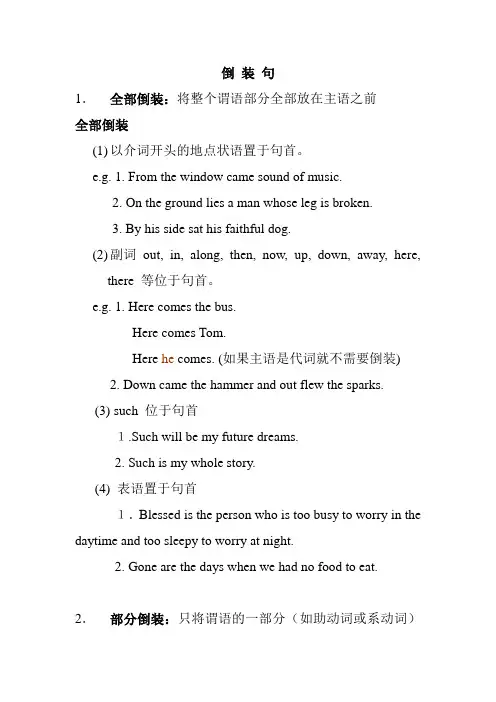
倒装句1.全部倒装:将整个谓语部分全部放在主语之前全部倒装(1)以介词开头的地点状语置于句首。
e.g. 1. From the window came sound of music.2. On the ground lies a man whose leg is broken.3. By his side sat his faithful dog.(2)副词out, in, along, then, now, up, down, away, here,there 等位于句首。
e.g. 1. Here comes the bus.Here comes Tom.Here he comes. (如果主语是代词就不需要倒装)2. Down came the hammer and out flew the sparks.(3) such 位于句首1.Such will be my future dreams.2. Such is my whole story.(4) 表语置于句首1.Blessed is the person who is too busy to worry in the daytime and too sleepy to worry at night.2. Gone are the days when we had no food to eat.2.部分倒装:只将谓语的一部分(如助动词或系动词)放在主语前面,其余部分仍在主语之后。
部分倒装(2)句首有否定词或否定短语时,句子要部分倒装。
A.常见的否定词有:never, hardly, scarcely, little, seldom, not, not until, rarely, no sooner…than, nowhere,etc.e.g. 1. Nowhere in the world can you find a man who ismore foolish than John.2. No sooner had I taken a bath than the bell rang.3. Not a word did he say at the meeting.4. Never before have I heard such a story.5. Not until he came back did I leave.(注意:主句中主谓结构部分倒装)6. Not only did we lose all our money, but we alsocame close to losing our lives.B.常见的否定短语有:in no way, in no case, at no time, by no means, in no sense, on no account, under nocircumstances放句首表示强调,译为“决不。
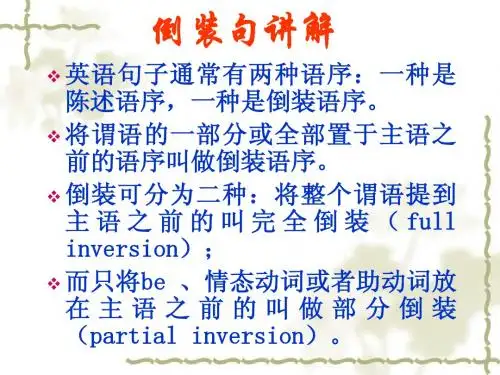
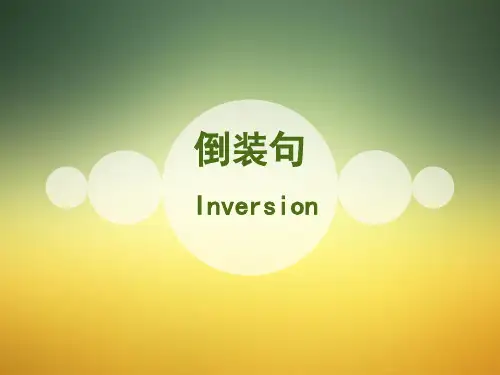
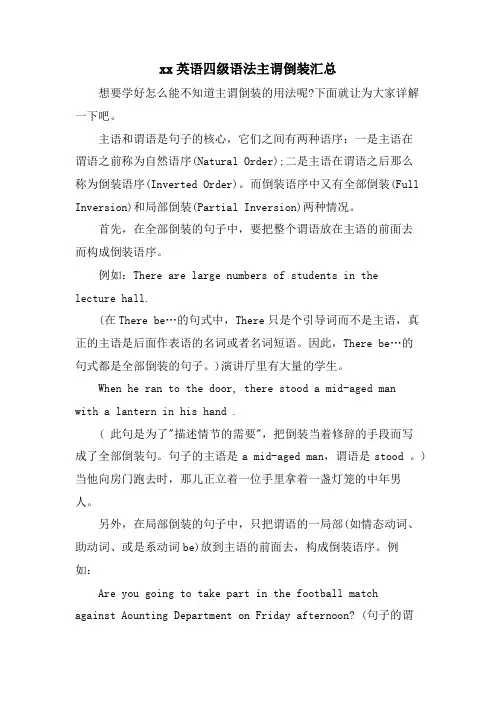
xx英语四级语法主谓倒装汇总想要学好怎么能不知道主谓倒装的用法呢?下面就让为大家详解一下吧。
主语和谓语是句子的核心,它们之间有两种语序:一是主语在谓语之前称为自然语序(Natural Order);二是主语在谓语之后那么称为倒装语序(Inverted Order)。
而倒装语序中又有全部倒装(Full Inversion)和局部倒装(Partial Inversion)两种情况。
首先,在全部倒装的句子中,要把整个谓语放在主语的前面去而构成倒装语序。
例如:There are large numbers of students in thelecture hall.(在There be…的句式中,There只是个引导词而不是主语,真正的主语是后面作表语的名词或者名词短语。
因此,There be…的句式都是全部倒装的句子。
)演讲厅里有大量的学生。
When he ran to the door, there stood a mid-aged manwith a lantern in his hand .( 此句是为了"描述情节的需要",把倒装当着修辞的手段而写成了全部倒装句。
句子的主语是a mid-aged man,谓语是stood 。
)当他向房门跑去时,那儿正立着一位手里拿着一盏灯笼的中年男人。
另外,在局部倒装的句子中,只把谓语的一局部(如情态动词、助动词、或是系动词be)放到主语的前面去,构成倒装语序。
例如:Are you going to take part in the football match against Aounting Department on Friday afternoon? (句子的谓语是are going to take part,are是句子的谓语的一局部;句子的主语是you 。
所以,此句是局部倒装的句子。
疑问句都是局部倒装句。
)你打算去参加星期五与会计系进展的足球赛吗?Hardly could he finish his test paper when the school bell rang .(由于语法要求的原因,本句写成了局部倒装的句子。
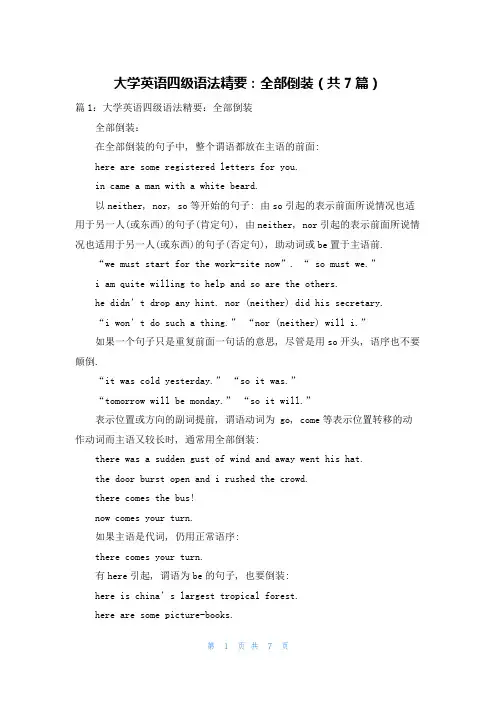
大学英语四级语法精要:全部倒装(共7篇)篇1:大学英语四级语法精要:全部倒装全部倒装:在全部倒装的句子中, 整个谓语都放在主语的前面:here are some registered letters for you.in came a man with a white beard.以neither, nor, so等开始的句子: 由so引起的表示前面所说情况也适用于另一人(或东西)的句子(肯定句), 由neither, nor引起的表示前面所说情况也适用于另一人(或东西)的句子(否定句), 助动词或be置于主语前.“we must start for the work-site now”. “ so must we.”i am quite willing to help and so are the others.he didn’t dro p any hint. nor (neither) did his secretary.“i won’t do such a thing.” “nor (neither) will i.”如果一个句子只是重复前面一句话的意思, 尽管是用so开头, 语序也不要颠倒.“it was cold yesterday.” “so it was.”“tomorrow will be monday.” “so it will.”表示位置或方向的副词提前, 谓语动词为 go, come等表示位置转移的动作动词而主语又较长时, 通常用全部倒装:there was a sudden gust of wind and away went his hat.the door burst open and i rushed the crowd.there comes the bus!now comes your turn.如果主语是代词, 仍用正常语序:there comes your turn.有here引起, 谓语为be的句子, 也要倒装:here is china’s largest tropical forest.here are some picture-books.如果主语是代词, 仍用正常语序:here we are. this is the new railway station.“give me some paper.” “here you are.”表语和系动词提前:介词短语: on the other side was northern xinjiang.near the southern end of the village was a large pear orchard.形容词: very important in the farmer’s life is the radio weather report.worst of all were the humiliations he suffered.副词: below is a restaurant.southwest of the reservoir were 2,000 acres of sandy wasteland.分词: housed in the cultural palace are a library, an auditorium and recreation rooms.hidden underground is a wealth of gold, silver, copper, lead and zink.lying on the floor was a boy aged about 17.standing beside the table was an interpreter.篇2:大学英语四级语法精要:部分倒装部分倒装在部分倒装的句子中只是谓语中的一部分(如助动词, 情态动词, 或系动词be等)放在主语前面, 其余部分仍在主语后面:under no circumstances must a soldier leave his post.i couldn’t answer the question. nor could anyone else in our class.only in this way is it possible to accomplish the above-mentioned glorious task.句首状语若由 only + 副词, only + 介词词组, only + 状语从句构成, 引起局部倒装:only yesterday did he find out that his watch was missing.only through sheer luck did he manage to get some tickets.only because there were some cancelled bookings did he get some tickets in the end.有not only开头的句子或分句, 往往引起局部倒装:not only did he complain about the food, he also refused to payfor it.not only did the garage overcharge me, but they hadn’t done a very good repair job either.当句首状语为 never, little, not only, not until, hardly, scarcely 等否定词或有否定意义的词语时, 一般引起部分倒装.no longer are they staying with us.no sooner had he arrived there than he fell ill.under no circumstances could i agree to such a principle.篇3:大学英语四级语法精要:分词分词意义: 过去分词通常来自及物动词, 带有被动意义和完成意义; 而现在分词有的来自及物动词, 有的来自不及物动词, 通常带有主动意义和未完成意义. frozen food a freezing winda bored traveller a boring journeya lost cause a losingbattlea conquered army a conquering armya finished article the last finishing touchthe spoken word a speaking birda closed shop the closing houra recorded talk a recording machine来自不及物动词的过去分词很少能单独用作前置修饰语, 能作这样用的仅限于下面几个词, 仅表示完成意义, 不表示被动意义.the risen sun, fallen leaves, faded/withered flowers, returned students, retired workers, departed friends, escaped prisoners, the vanished jewels, newly-arrived visitors用作后置修饰语的过去分词一般都带有修饰语或其他成分, 在意义上相当于关系分句.Most of the people invited to the reception were old friends.篇4:大学英语四级语法精要:动词动词只能用动名词作宾语的动词: suggest, finish, avoid, stop, can’t help, mind, admit, enjoy, leave off, require, postpone, put off, delay, practise, fancy, excuse, pardon, advise, consider, deny, endure, escape, miss既可用动名词, 也可用不定式作宾语的动词: love, like, hate, dislike, begin, start, continue, intend, attempt, can’t bear, propose, want, need, remember, forget, regret, neglect, try, deserve, can’t afford等.有时两种结构之间意义差别不大, 有时却有不同的意思. 在remember, regret, want, try等词后差别是比较明显的.i remember seeing her once somewhere.i must remember to take my notebooks with me.i regret not having accepted your advice.i regret to say i haven’t given you enough help.she doesn’t want (need) to come.the house wants (needs) cleaning.we must try to get everything done in time.let’s try doing the work some other way.悬垂修饰: 分词作状语时, 表示的必须是主语的一个动作或状态.walking through the park, we saw a lot of flowers. (walking是we 的动作, 正确)walking through the park, the flowers looked very beautiful. (错误)standing on the tower, we could see the whole city. (正确)standing on the tower, the whole village could be seen. (错误) 篇5:大学英语四级语法精要:连词Ⅴ 连词并列连词表示意义的引申: and, both…and, not only…but(also), as well as, and …as well, neither…nor表示选择: or, either…or表示转折: but, while, whereas, yet, however/nevertheless(也可认为是副词)表示因果: for, so, therefore, hence从属连词表示时间: when, while, as, after, before, since, until(till), as soon as, once表示原因: because, as, since, now that, seeing that表示条件: if, unless, in case, provided(that), suppose, as long as, on condition (that),表示其他关系: (al)though, than, as/so…as, lest, in order that, so…that篇6:大学英语四级语法精要:动名词结构前面带有代词或名词的动名词结构: 一个动名词前面可以加一个物主代词(或名词的所有格结构), 来表示这个动名词逻辑上的主语.Their coming to help was a great encouragement to us.Our sole worry is your relying too much on yourself.Do you mind my reading your paper?They insisted on my staying there for supper.如果不是在句子开头, 这个结构常常可以用名词的普通格(或人称代词宾格), 这比用所有格更自然一些.I don’t mind him going.She hates people losing their temper.篇7:大学英语四级语法精要:比较级和最高级Ⅷ 比较级和最高级无比较级和最高级的形容词及副词: complete, perfect, utter, etc 比较从句as…as, almost/just/nearly as…as, not so/as …as:we’ll give you as much help as we can.i haven’t made as much progress as i should.we’ve produced twice as much cotton this year as we did ten years ago.my command of english is not half so (as) good as yours.than, so much/a lot more tha n, no more… than, not more…than, less thanmore…than, less…than可表示“与其说…不如说…”:he is more good than bad.he was less hurt than frightened.the present crisis in capitalist countries is much more a political than an economic crisis.“no + 形容词或副词比较级+ than”所表示的可以是该形容词或副词的相反的含义:no rich than = as poor asno bigger than = as small asno later than = as early asjohn is no better than tom.i have taken no more than six courses this semester.the more… the mor e (越是…就越…)actually, the busier he is, the happier he feels.the more they talked, the more encouraged they felt.more of a, as much of a, less of a, etc: 当as much of a…as, more/less of a …than等结构与单数可数名词搭配时, 名词只能置于比较结构中间.he is more of a sportsman than his brother.。
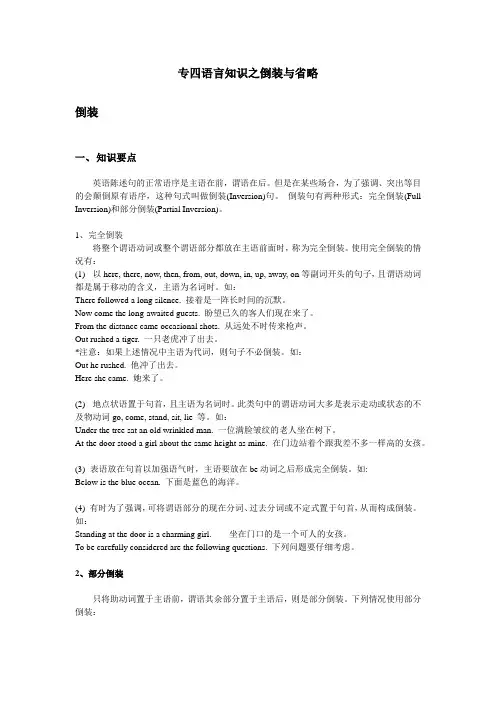
专四语言知识之倒装与省略倒装一、知识要点英语陈述句的正常语序是主语在前,谓语在后。
但是在某些场合,为了强调、突出等目的会颠倒原有语序,这种句式叫做倒装(Inversion)句。
倒装句有两种形式:完全倒装(Full Inversion)和部分倒装(Partial Inversion)。
1、完全倒装将整个谓语动词或整个谓语部分都放在主语前面时,称为完全倒装。
使用完全倒装的情况有:(1)以here, there, now, then, from, out, down, in, up, away, on等副词开头的句子,且谓语动词都是属于移动的含义,主语为名词时。
如:There followed a long silence. 接着是一阵长时间的沉默。
Now come the long-awaited guests. 盼望已久的客人们现在来了。
From the distance came occasional shots. 从远处不时传来枪声。
Out rushed a tiger. 一只老虎冲了出去。
*注意:如果上述情况中主语为代词,则句子不必倒装。
如:Out he rushed. 他冲了出去。
Here she came. 她来了。
(2)地点状语置于句首,且主语为名词时。
此类句中的谓语动词大多是表示走动或状态的不及物动词go, come, stand, sit, lie 等。
如:Under the tree sat an old wrinkled man. 一位满脸皱纹的老人坐在树下。
At the door stood a girl about the same height as mine. 在门边站着个跟我差不多一样高的女孩。
(3)表语放在句首以加强语气时,主语要放在be动词之后形成完全倒装。
如:Below is the blue ocean. 下面是蓝色的海洋。
(4) 有时为了强调,可将谓语部分的现在分词、过去分词或不定式置于句首,从而构成倒装。

Be it ever so 倒装省略的特殊结构, 作表示让步的状语"be it ever(never)so"和"let it be ever(never)so"结构,这里,"be it"中的"be"是古英语假设语气的遗留形式,现代英语则使用"let it be"。
"ever so"和"never so"都表示同一意思,都表示"very"。
Be it ever so humble (let it be ever so humble), home is home.△Be+主语+ever so+形容词=No matter wh-词+形容词+主语+may be。
Be a man ever so clever, he knows nothing if he doesn’t learn.人不论多聪明,不学就无知。
△Be+主语+表语or表语=No matter/whether…or…Be he friend or enemy, the law regards him as a criminal.不论他是敌是友,法律认为他是罪犯。
倒装句精讲及练习"倒装句"主要指的是谓语语序的倒装,当然也有宾语和表语语序的倒装。
倒装句分为两种,部分倒装(将谓语的一部分提到主语之前)和全部倒装(将谓语的全部提到主语之前)。
一、部分倒装部分倒装是把be动词、情态动词、助动词放到主语之前。
如果句子中没有这些词,要在主语之前加助动词do / does / did等,而把原来的谓语动词变成原形放在主语之后。
部分倒装主要有以下几种情况:1. 句首状语为否定词或半否定词的句子。
这类词或短语主要有never, neither, nor, little, seldom, rarely, hardly, scarcely, no sooner, not only, in no way, at no time, few, not, no等, 如:Not a word did I say to him.Never have I found him so happy.Little does he care about what I said.I can't swim. Neither can he.No sooner had he gone to bed than he fell asleep.巩固练习:1) Hardly ________ the airport when the plane took off.A. I had arrived atB. had I arrivedC. had I reachedD. I had got to2) —Have you ever seen anything like that before?—No, ________ anything like that before.A. I never have seenB. never I have seenC. never have I seenD. I have seen3) She is not fond of cooking, ________ I.A. so amB. nor amC. neitherD. nor do2. only + 状语放在句首,要部分倒装。
Inversion 倒装带否定意义的副词置于句首时带否定意义的词置于句首时,主谓语需要倒装。
Rarely does he go to the movies.Not for a moment did he doubt the truth of her honesty.Little do I know about the meaning of this proverb.Never before the night had I felt the extent of mypower.含有否定词的介词短语在句首时含有否定词的介词短语在句首时,句子主谓倒装。
这类介词短语包括:in no case, at no time, in no way, by no means, on no account, in no sense,u nder no circumstances, 等等。
意思为“决不,在任何情况下都不。
”“Only+状语”置于句首时的倒装“Only+状语”置于句首时,主谓语需要倒装。
1) Only by practicing a lot outside class can we speak English fluently.2) Only when I saw him did I remember that I promised to bring him a gift.3) Only then did I know that I was wrong.not only位于句首时的倒装句首是not only且连接分句结构时,引起局部(部分)倒装。
Not only did we lose our money, but we were also in danger of losing our live s.Not only can he sing very well, but he can also play some musical instrumen t very skillfully.neither,nor表示“也不”时的倒装句首是neither,nor表示“也不”时,主谓语需要倒装。
英语倒装句浓缩版1. 当以there, here, out , in , up , down, away 等副词开头的句子,为了起到强调的作用,可构成倒装句,只把副词放在句首,主语和谓语位置调换,不加助动词。
【名词倒装,代词不倒装】Our teacher came in. In came our teacher.这种倒装要求:主语必须是名词。
主语是人称代词时,主语和谓语语序不变。
Here it is. / Away he went. /Look, there he comes. 看,他来了。
/Down she went.她下来了。
这类倒装句式一般只用一般现在时和一般过去时。
Here comes the bus.Out rushed the boys.2. 副词now, then, thus 引导的句子里,谓语是come, follow, begin, end, be 等.Now comes your turn! 到你了。
Thus ended the meeting. 会议结束了。
Then came the dog.Then came 8 years of the Anti Japanese War.3. 表地点状语的介词短语放在句首,要用倒装句式,以示强调。
这种倒装句也是主谓直接调换位置,不加助动词did, does或do. Under a big tree __D______, half asleep.A. did sat a fat manB. a fat man satC. did a fat man satD. sat a fat man4. there放在句首时,要用倒装句式。
在“there + lives, stands, comes, lies, flows, enters, rises 和appears等。
There came shouts for help from the river.There lies a large wheat field in front of the house.Many years ago there lived an old man in the wooden house. In front of the tower flews a stream. 5. so + 动词+主语 ; neither/ nor + 动词+主语表示两人的同样一个情况时,只能表示一件事,即上、下句所使用的动词、时态要一致。
否则要用so it is with…You can ride a bike. So can I . He has been to Beijing. S o have I .The first one isn’t good, neither is the second. He can’t do it. Neither/nor can I.His uncle is a worker and has been working in the factory for more than ten years. So it is with his aunt.6. so+ 形容词/副词that 的结构状语从句可以用正常语序表示,也可以把so+形容词/副词放于句首构成倒装。
句型如下: so +形容词/副词+be/助动词/情态动词that +从句。
Light travels so fast that it is difficult for us to imagine its speed.= So fast does light travel that it is difficult for us to imagine its speed. S o easy was the work that they finished it in a few days.So cold was the weather that we had to stay at home.So frightened was he that he did not dare to move an inch. 他害怕得很,动也不敢动。
So dark was the room that I could hardly see anything. 屋子如此黑我什么也看不见。
So careless did he drive that he almost killed himself. 他开车如此粗心,差点把自己害死了。
7) such(在句子开头) …that也有倒装用法Such a good boy is he that he is always ready to help =So good a boy is he that he is always ready to help8. 否定副词not , never, seldom, nowhere, little , rarely 放于句首时要用倒装句式。
We seldom get up at four in the morning. = Seldom do we get up at four in the morning.Not a single word from him could the enemy drag(敌人从他的口中问不出一句话来).Rarely have I heard of such a silly thing(以前我很少听到这样的蠢事). Little does he care about what others think(他很少在意别人怎么想). Never (before)have I seen such a good harvest.9. hardly…when;scarcely…when…; no sooner…than…可以用正常语序 had hardly done when… did 或用倒装句式Hardly had + 主语+ done when… did 句式。
hardly所在的句子用过去完成时。
原始句子为:The bell had hardly/scarcely rung when the class began.=The bell had no sooner rung than the class began.= Hardly had the bell rung when the class began. (使用倒装)No sooner had he arrived in Beijing than he began to work.=Scarcely had he arrived in Beijing when he began to work (使用倒装)10. not only… but also 如连接两个成分时,不用倒装;连接句子时,前面的句子要用倒装。
Not only was everything that he had taken away from him, but also his German citizenship.Not only is he busy, but also I have a lot of work to do.Not only does he speak English very well, but also he speaks French well .11. only 及所修饰的副词、介词短语或状语从句放在句首时,要用: only+ 状语+ be /助动词/情态动词+主语及其他Only when he told me the news did I know what had happened.Only in this way can you make progress in your English.12. 虚拟语气中的倒装句If I were you, I would take the job. = Were I you, I would take the job Were it to rain(=If it were to rain), the crops would be saved. 要是下雨了,庄稼就有救了。
Had you come here(=If you had come here), you would have met the film star. 你要是来了的话就能见到那位电影明星了。
Were they here(=If they were here), they would help us. 他们要是在这儿,他们会帮助我们的。
13. By no means(绝不)/At no time(绝不),in no way(绝不), under no circumstance(绝不)在开头, 引起倒装。
By no means/At no time can you tell a lie. 你绝不能撒谎。
14)“作表语的现在分词/过去分词/形容词+系动词+主语”形式的完全倒装Seated in the front were the guests. Injured are those soldiers.Gone forever are the days when the Chinese people had to use foreign oil.15)表示地点,时间,方向等的介词短语放在句首时例如:After the head walked a group of workers.In front of the house stopped a police car. 一辆警车停在房子前面。
Under the tree sat a boy. 一个男孩坐在树下。
In my heart was desire to live more dangerously. 我的心渴望一种更加惊险的生活。
16) Not until+ then/ 3 o’clock /不倒装的句子+倒装句It was not until +不倒装的句子+that 不倒装的从句Not until then/ 3 o’clock/I came back did I realize I was wrong.Not until the child fell asleep did the mother leave the room. 母亲一直到孩子入睡后离开房间。
It was not until the child fell asleep that the mother left the room.注意:如否定词不在句首不倒装。